|
|
|
Sort Order |
|
|
|
Items / Page
|
|
|
|
|
|
|
| Srl | Item |
| 1 |
ID:
113968
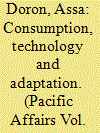

|
|
|
|
|
| Publication |
2012.
|
| Summary/Abstract |
On the edges of the digital world in India, there are millions of mobile phone users. To cater for these consumers, an economy of mobile phone care and repair has emerged in almost every town. Through the experiences of consumers and repairers, this article explores technology distribution, service practices and economic opportunity. How do they learn their trade? How do they make a living? And how do they position themselves in relation to the official branded manufacturers and licensed agents? Conceptually, the article is concerned with the nexus between consumer culture, the Indian middle class and the poor and how they engage global capitalism. It argues that middle-class ideologies and practices of consumption are both exclusive and expansive. At the same time, the poor seek to engage this economy by tapping into the unauthorized sector that responds to their demands for local participation in the global economy, while keeping them also at a certain distance from the forms and symbolic capital of the new economy.
|
|
|
|
|
|
|
|
|
|
|
|
|
|
|
|
| 2 |
ID:
180059
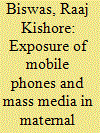

|
|
|
|
|
| Summary/Abstract |
Communications through mobile phones and mass media have shown to be useful for health promotion activities in developing nations. This study explored the potential association of mothers’ mobile phone ownership and mass media exposure on maternal health care services in a developing nation setting: urban Bangladesh. The Urban Health Survey 2013 was examined for antenatal care, delivery assistance, and postnatal care of both mothers and children through multiple regression models, adjusting for sociodemographic factors. Among 8987 ever-married female respondents, 64.1% owned mobile phones and 88% were exposed to mass media (TV, radio or newspaper) at least once a week. Mobile phone ownership was associated with a 48% greater likelihood of access to antenatal care, 34% greater delivery assistance and 31% greater postnatal care of the mother, but no differences were found for postnatal care of children. Similarly, frequent media exposure was associated with increased access to antenatal care (38%) and delivery assistance (46%), but not associated with postnatal care of mothers or children. The results suggested that mobile phones and mass media could be valid avenues for promoting access to maternal health services, and thus, support for mobile phone access and investment in awareness campaigns targeting relevant communities are worthwhile
|
|
|
|
|
|
|
|
|
|
|
|
|
|
|
|
| 3 |
ID:
113963
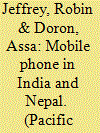

|
|
|
|
|
| Publication |
2012.
|
| Summary/Abstract |
This article scans the effects of mobile-phone communication, particularly in South Asia. It focuses on three important areas: political economy, politics and social practices. By 2012 India had more than 900 million telephone subscribers, 96 percent of them on cell phones, and the majority of users were the poor. At the other end of the social scale, the mobile phone provoked bitter struggles among some of India's biggest business houses and branches of government, and was responsible for criminal cases against politicians at the highest level.
The essays in this volume are a reminder that technology is anything but neutral. The essays examine the many facets of mobile phone communication and the institutions, agents, mechanisms and networks such communication relies on. The essays contribute to efforts to interpret the effects of this technology and to gain insight into the most important aspect of the mobile phone: the sheer variety of activity (political, social and cultural) on which it impinges.
|
|
|
|
|
|
|
|
|
|
|
|
|
|
|
|
| 4 |
ID:
127928
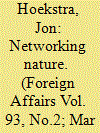

|
|
|
|
|
| Publication |
2014.
|
| Summary/Abstract |
Conservation is for the first time beginning to operate at the pace and on the scale necessary to keep up with, and even get ahead of, the planet's most intractable environmental challenges. New technologies have given conservationists abilities that would have seemed like super powers just a few years ago. We can now monitor entire ecosystems -- think of the Amazon rainforest -- in nearly real time, using remote sensors to map their three-dimensional structures; satellite communications to follow elusive creatures, such as the jaguar and the puma; and smartphones to report illegal logging.
|
|
|
|
|
|
|
|
|
|
|
|
|
|
|
|
| 5 |
ID:
164815
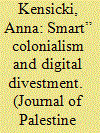

|
|
|
|
|
| Summary/Abstract |
Much has been written about how information communication technologies (ICTs) detract from nations' planning and development norms, but there remains insufficient theoretical examination of the way ICTs may drive extranormative national aims. This paper examines such a case by disentangling the complicated relationships between telecommunications, city planning, and economic development in one modern settler-colonial context. The author explores how planning and development norms are adulterated in Palestine-Israel to further a select set of interests, in the service of an evolving national project. Palestinian and Israeli demographics and telecommunications infrastructure on both sides of the Green Line are examined, revealing the role of these technologies in facilitating population dispersal, economic exploitation, and political control at various stages of settler colonialism.
|
|
|
|
|
|
|
|
|
|
|
|
|
|
|
|
|
|
|
|
|